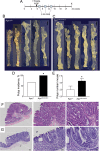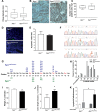Nuclear adenomatous polyposis coli suppresses colitis-associated tumorigenesis in mice
- PMID: 24894865
- PMCID: PMC4123651
- DOI: 10.1093/carcin/bgu121
Nuclear adenomatous polyposis coli suppresses colitis-associated tumorigenesis in mice
Abstract
Mutation of tumor suppressor adenomatous polyposis coli (APC) initiates most colorectal cancers and chronic colitis increases risk. APC is a nucleo-cytoplasmic shuttling protein, best known for antagonizing Wnt signaling by forming a cytoplasmic complex that marks β-catenin for degradation. Using our unique mouse model with compromised nuclear Apc import (Apc(mNLS)), we show that Apc(mNLS/mNLS) mice have increased susceptibility to tumorigenesis induced with azoxymethane (AOM) and dextran sodium sulfate (DSS). The AOM-DSS-induced colon adenoma histopathology, proliferation, apoptosis, stem cell number and β-catenin and Kras mutation spectra were similar in Apc(mNLS/mNLS) and Apc(+/+) mice. However, AOM-DSS-treated Apc(mNLS/mNLS) mice showed more weight loss, more lymphoid follicles and edema, and increased colon shortening than treated Apc(+/+) mice, indicating a colitis predisposition. To test this directly, we induced acute colitis with a 7 day DSS treatment followed by 5 days of recovery. Compared with Apc(+/+) mice, DSS-treated Apc(mNLS/mNLS) mice developed more severe colitis based on clinical grade and histopathology. Apc(mNLS/mNLS) mice also had higher lymphocytic infiltration and reduced expression of stem cell markers, suggesting an increased propensity for chronic inflammation. Moreover, colons from DSS-treated Apc(mNLS/mNLS) mice showed fewer goblet cells and reduced Muc2 expression. Even in untreated Apc(mNLS/mNLS) mice, there were significantly fewer goblet cells in jejuna, and a modest decrease in colonocyte Muc2 expression compared with Apc(+/+) mice. Colonocytes from untreated Apc(mNLS/mNLS) mice also showed increased expression of inflammatory mediators cyclooxygenase-2 (Cox-2) and macrophage inflammatory protein-2 (MIP-2). These findings reveal novel functions for nuclear Apc in goblet cell differentiation and protection against inflammation-induced colon tumorigenesis.
© The Author 2014. Published by Oxford University Press. All rights reserved. For Permissions, please email: journals.permissions@oup.com.
Figures





Similar articles
-
A knock-in mouse model reveals roles for nuclear Apc in cell proliferation, Wnt signal inhibition and tumor suppression.Oncogene. 2012 May 10;31(19):2423-37. doi: 10.1038/onc.2011.434. Epub 2011 Sep 26. Oncogene. 2012. PMID: 21996741 Free PMC article.
-
EGFR in Tumor-Associated Myeloid Cells Promotes Development of Colorectal Cancer in Mice and Associates With Outcomes of Patients.Gastroenterology. 2017 Jul;153(1):178-190.e10. doi: 10.1053/j.gastro.2017.03.053. Epub 2017 Apr 9. Gastroenterology. 2017. PMID: 28400195 Free PMC article.
-
Elevated adenomatous polyposis coli in goblet cells is associated with inflammation in mouse and human colon.Exp Physiol. 2020 Dec;105(12):2154-2167. doi: 10.1113/EP088970. Epub 2020 Nov 4. Exp Physiol. 2020. PMID: 33150708
-
Adenomatous polyposis coli (APC) plays multiple roles in the intestinal and colorectal epithelia.Med Mol Morphol. 2007 Jun;40(2):68-81. doi: 10.1007/s00795-006-0352-5. Epub 2007 Jun 18. Med Mol Morphol. 2007. PMID: 17572842 Review.
-
Nuclear APC.Adv Exp Med Biol. 2009;656:13-29. doi: 10.1007/978-1-4419-1145-2_2. Adv Exp Med Biol. 2009. PMID: 19928349 Free PMC article. Review.
Cited by
-
Chemopreventive Effects of Edible Canna (Canna edulis Kerr.) Against Colorectal Carcinogenesis: Effects on Expression of Adenomatous Polyposis Coli and Inducible Nitric Oxide Synthase in Rat Inflammatory Model.Asian Pac J Cancer Prev. 2018 Mar 27;19(3):839-844. doi: 10.22034/APJCP.2018.19.3.839. Asian Pac J Cancer Prev. 2018. PMID: 29582643 Free PMC article.
-
Hepatoprotective Effect of Carboxymethyl Pachyman in Fluorouracil-Treated CT26-Bearing Mice.Molecules. 2017 May 6;22(5):756. doi: 10.3390/molecules22050756. Molecules. 2017. PMID: 28481246 Free PMC article.
References
-
- Terzić J., et al. (2010). Inflammation and colon cancer. Gastroenterology, 138, 2101–2114.e5 - PubMed
-
- Din F.V., et al. (2010). Effect of aspirin and NSAIDs on risk and survival from colorectal cancer. Gut, 59, 1670–1679 - PubMed
-
- Borrello M.G., et al. (2008). Inflammation and cancer: the oncogene-driven connection. Cancer Lett., 267, 262–270 - PubMed
Publication types
MeSH terms
Substances
Grants and funding
LinkOut - more resources
Full Text Sources
Other Literature Sources
Medical
Molecular Biology Databases
Research Materials
Miscellaneous

